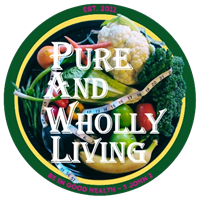Many of us love the idea of a diverse, colorful salad because it is visually appealing. But beyond creating a vibrant plate, did you know varying your colors is good for your health?
Identifying the multitude of health benefits for each individual food can be a challenge, even for a savvy Health Coach. There’s just so many of them! But while whole foods like vegetables and fruit contain enough complex sources of nourishment to make your head spin if you tried to learn them all, they are generally categorized into a limited number of colors.
Before we get into those colors and their benefits, let’s talk about why you should be eating by color.
The importance and benefits of eating by color
If you think that eating by color will have no impact on your overall health, think again! There are tons of benefits to approaching your plate with this mindset, but here are a few of the top reasons why you should eat by color.
Eating by color can help protect your heart
Fruits and vegetables are packed with different kinds of vitamins, nutrients, and phytonutrients—all of which have various benefits for fighting disease, improving organ function, and protecting the body. Studies have shown that people who increased their daily consumption of fruits and vegetables saw a decrease in their risk of coronary heart disease. This was especially the case with deep orange fruits and green leafy vegetables, which are high in polyphenols (compounds rich in antioxidants).
Eating by color can help lower your risk of disease and illness
Studies have long shown that consuming plant foods is strongly correlated with reduction of chronic disease. This includes diseases like cardiovascular disease, diabetes, and cataracts, as well as cancer, dementia, obesity, and more. Also, recent research demonstrates that “diets high in anti-inflammatory compounds such as polyphenols and other phytochemicals may help to offset pollutant toxicity.” In other words, plant-rich diets can lower our risk of diseases related to environmental toxins, too. So if you’re trying to avoid disease (aren’t we all?), adding more fruits and vegetables to your plant is a good place to start.
Eating by color can improve your eye health
Many fruits and vegetables are high in vitamin A — carrots, mangoes, sweet potatoes, cantaloupe, apricots, spinach, kale, collard greens, papaya, etc. — which supports your vision. In addition, the National Institute of Health has found that consuming high doses of vitamins C and E, beta-carotene, zinc, and copper can slow the progression of age-related macular degeneration, which is a major cause of loss of vision in older adults.
It can even lower the level of bad cholesterol in your body, and lower your blood pressure.
Yes, eating the rainbow can decrease your LDL cholesterol levels and your blood pressure! Research has shown that eating a variety of fruits and vegetables has a significant impact on health markers like blood pressure and oxidative damage. In particular, leafy greens have been shown to reduce blood pressure, including spinach, chard, dark lettuces, collard greens, and kale. To lower your bad and total cholesterol levels, add tomatoes, blue/purple foods, and foods high in beta-carotene (orange, dark green, red, and yellow foods) to your diet.
Bottom line: Eating a wide array of colors every day is the best approach to getting all the vitamins and minerals your body needs to function at its best.
The most common food colors
What gives a fruit or vegetable color? The answer: phytonutrients! All natural foods have a unique color, flavor, and smell. Simply looking at their color can give you great insight as to what element of health various foods are likely to support.
Now that you know why eating by color matters, here are the most common food colors and their nutritional attributes:
White
Naturally white foods have a wide range of beneficial nutrients, such as anthoxanthins, sulfur, and quercetin. These substances boost the immune system because they are anti-viral, anti-fungal, and anti-inflammatory, which helps the body fight infections.
Examples of white foods include garlic, onions, cauliflower, and daikon radish.
Green
Green foods get their color from chlorophyll, a natural blood purifier that supports the liver and kidneys in the elimination of toxins. Among many other nutrients, green foods also contain high amounts of Vitamin K, which is necessary for blood clotting and building strong bones.
Examples of green foods include kale, broccoli, spinach, green beans, and celery.
Yellow
Yellow foods are rich in Vitamin C, which helps reduce inflammation, prevent allergies, and maintain healthy skin, due to its’ ability to combat free radicals. Yellow foods also contain citrus bioflavonoids, which strengthens the collagen in your skin, tendons, ligaments, and cartilage.
Examples of yellow foods include lemons, pineapples, yellow peppers, and grapefruit.
Orange
Orange foods are high in beta-carotene, which our bodies transform into Vitamin A and antioxidants. These nutrients aid in the prevention of cancer, heart disease, and infections by supporting an important part of the immune system: our mucous membranes. Beta-carotene also helps maintain healthy eyes and skin.
Examples of orange foods include carrots, cantaloupe, sweet potatoes, squash, and oranges.
Red
Red foods are rich in the phytonutrients lycopene and anthocyanin, which greatly benefits the circulatory system by helping build healthy cell walls. This improves blood pressure, organ function, and circulation. Red foods also offer sun protection from harmful UV damage.
Examples of red foods include tomatoes, watermelon, beets, and red bell peppers.
Purple
Purple foods contain the most antioxidants of all the colors and therefore contribute to overall health, disease prevention, and longevity. They also raise HDL (the “good”) cholesterol, and help maintain a healthy brain.
Examples of purple/blue foods include blueberries, blackberries, eggplant, and purple cabbage.
Adapted by Diana Chaplin
